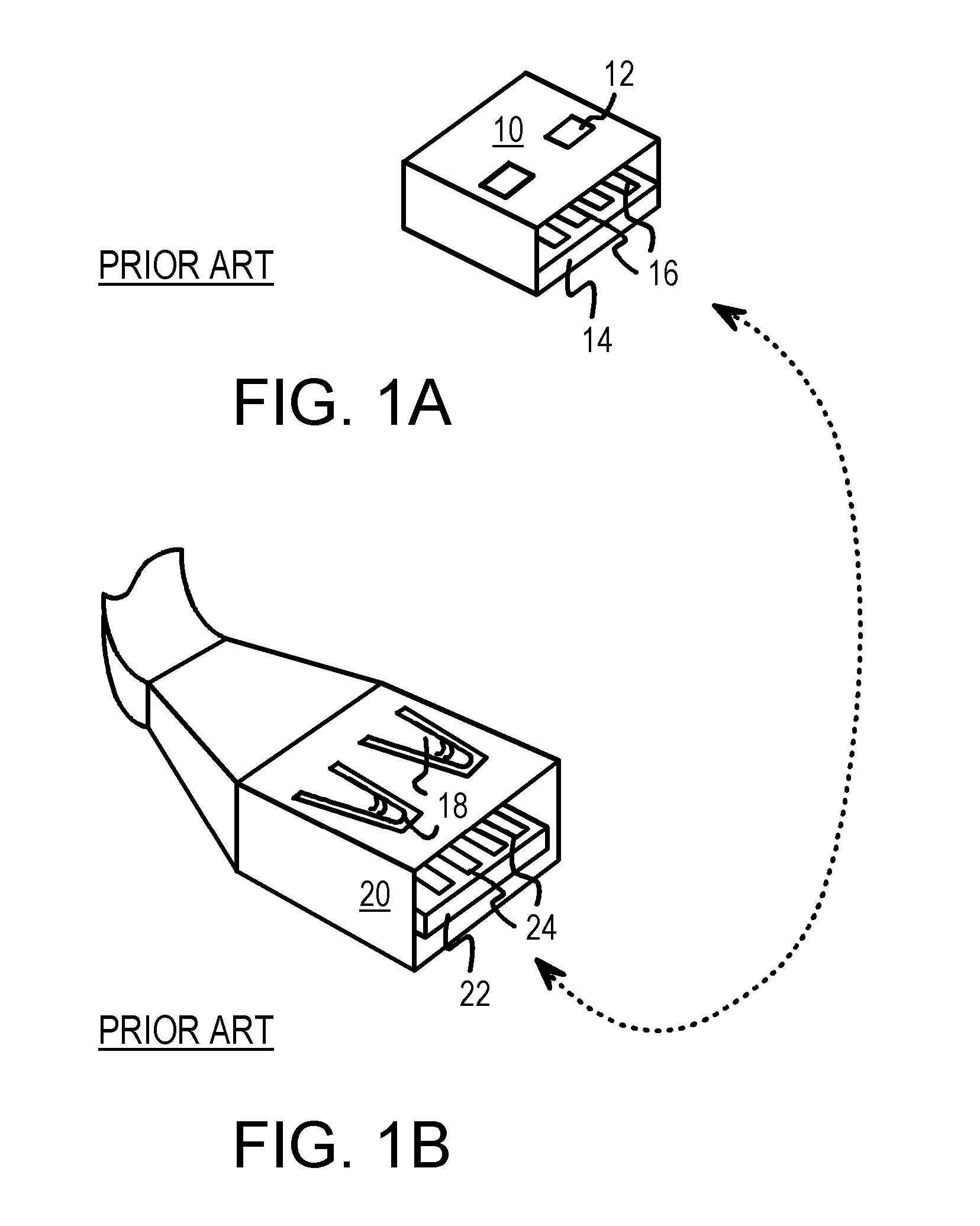Dual-personality extended-USB plug and receptacle with PCI-Express or Serial-At-Attachment extensions
a usb connector and serial extension technology, applied in the field of serial bus connectors, can solve the problems of limiting the use of expresscards, large connectors, and metal contacts of usb connectors with b>4/b> metal contacts that do not support the more complex pci express standard,
- Summary
- Abstract
- Description
- Claims
- Application Information
AI Technical Summary
Benefits of technology
Problems solved by technology
Method used
Image
Examples
first embodiment
[0037]FIGS. 4A–I show extended USB connectors and sockets having metal contact pins on both top and bottom surfaces of the pin substrates. In FIG. 4A, the extended connector has plastic housing 76 that the user can grip when inserting the connector plug into a socket. Pin substrate 70 supports metal contact pins 88 on the top surface. Pin substrate 70 is an insulator such as ceramic, plastic, or other material. Metal leads or wires can pass through pin substrate 70 to connect metal contact pins 88 to wires inside plastic housing 76 that connect to the peripheral device.
[0038]Reverse-side metal contact pins 72 are placed in a recess in the bottom side of pin substrate 70 near the tip of the connector plug. Ribs can be added alongside contact pins 72 to further prevent shorting. Reverse-side metal contact pins 72 are additional pins for extended signals such as for PCI-Express signals. Metal leads or wires can pass through pin substrate 70 to connect reverse-side metal contact pins 72...
second embodiment
[0050]FIGS. 5A–H show extended USB connectors and sockets having metal contact pins on just one of the surfaces of the pin substrates. In FIG. 5A, the extended connector has plastic housing 96 that the user can grip when inserting the connector plug into a socket. Pin substrate 90 supports metal contact pins 100, 101 on the top surface. Pin substrate 90 is an insulator such as ceramic, plastic, or other material. Metal leads or wires can pass through pin substrate 90 to connect metal contact pins 100, 101 to wires inside plastic housing 96 that connect to the peripheral device.
[0051]The length of pin substrate 90 is longer than the length L2 of pin substrate 34 in the prior-art USB connector of FIG. 3A. The extension in length can be 2–5 millimeters. Tip-end metal contact pins 101 are located mostly in the extension region beyond L2. Metal cover 93 is a rectangular tube that surrounds pin substrate 90 and has an open end.
[0052]FIG. 5B shows an extended-USB socket having metal contac...
third embodiment
[0062]FIGS. 6A–H show extended-function USB connectors and sockets using extended pins on a pivoting substrate attached to the socket's pin substrate. The length and depth do not have to be extended in this embodiment, or can be extended less than the embodiments of FIGS. 4, 5.
[0063]In FIG. 6A, the connector has plastic housing 56 that the user can grip when inserting the connector plug into a socket. Pin substrate 50 supports metal contact pins 68 on the top surface. Pin substrate 50 is an insulator such as ceramic, plastic, or other material. Metal leads or wires can pass through pin substrate 50 to connect metal contact pins 68 to wires inside plastic housing 56 that connect to the peripheral device.
[0064]Reverse-side metal contact pins 52 are placed in a recess in the bottom side of pin substrate 50 near the tip of the connector plug and can have raised ribs on each side to prevent contact with the spring-like clips on the metal cover of the standard USB socket. Reverse-side met...
PUM
 Login to View More
Login to View More Abstract
Description
Claims
Application Information
 Login to View More
Login to View More - R&D
- Intellectual Property
- Life Sciences
- Materials
- Tech Scout
- Unparalleled Data Quality
- Higher Quality Content
- 60% Fewer Hallucinations
Browse by: Latest US Patents, China's latest patents, Technical Efficacy Thesaurus, Application Domain, Technology Topic, Popular Technical Reports.
© 2025 PatSnap. All rights reserved.Legal|Privacy policy|Modern Slavery Act Transparency Statement|Sitemap|About US| Contact US: help@patsnap.com



